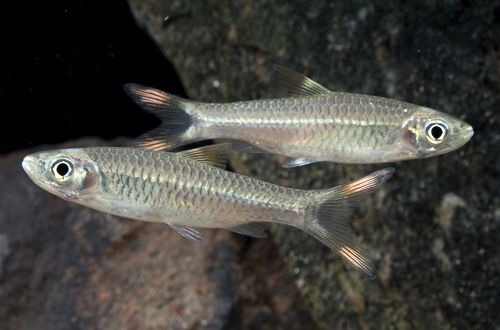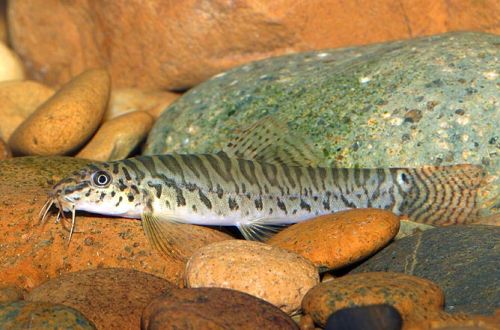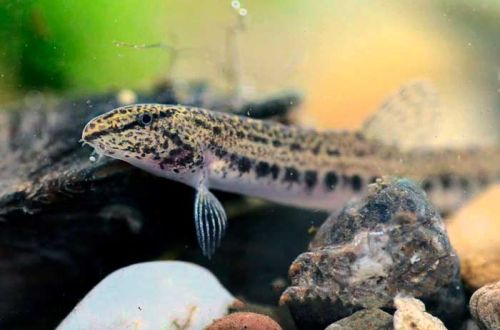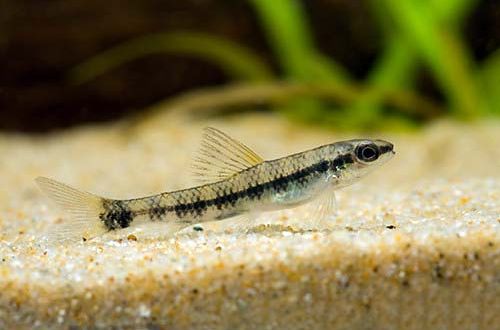
rasbora piedtail
The variegated rasbora, scientific name Rasbora caudimaculata, belongs to the Cyprinidae family. Flocking, mobile fish, medium size. It does not differ in the brightness of the color, but it compensates for this with high activity, it is constantly in motion and is able to add dynamics, revive any freshwater aquarium.

Contents
Habitat
It comes from Southeast Asia, the natural distribution area is limited to peninsular Malaysia, the islands of Borneo and Sumatra. Apparently, this species easily adapts to various conditions, since it is also found in small rivers and streams with a moderate course and in peat bogs with brownish water saturated with tannins and other chemicals released during the decomposition of organic matter.
Brief information:
- The volume of the aquarium – from 300 liters.
- Temperature – 20-26°C
- Value pH — 5.0–7.5
- Water hardness – soft (2-10dGH)
- Substrate type – any
- Lighting – subdued or moderate
- Brackish water – no
- Water movement – weak or moderate current
- The size of the fish is up to 15 cm.
- Food – any food
- Temperament – peaceful, very active
- Keeping in a flock of 6 individuals
Description
Relatively large fish, adults reach a length of 15 cm. Females are somewhat larger than males, the latter look more elegant. The color of the body is silver, only at the tips of the tail there are reddish or orange marks, to which the Rasbora variegated owes its name. The tail itself has a deep notch and is shaped like scissors.
Food
Accepts all types of dry, frozen and live food. The diet should be varied, combining different types of food, for example, flakes / pellets with bloodworms, mosquito larvae, etc. Feed 2-3 times a day in the amount eaten in 5 minutes. Feed residues are removed to prevent unnecessary water pollution.
Maintenance and care, arrangement of the aquarium
It is possible to provide comfortable conditions in a tank from 300 liters with a large free space for swimming. The design can be anything – both imitating the bottom of a fast river with a rocky substrate, and a section of a peat swamp littered with fallen leaves with numerous snags, branches and tree roots. All decorations, including plants, should be placed along the side walls of the aquarium to keep enough open water for Rasboras to swim freely.
The set of equipment is standard and includes filtration and lighting systems, an aerator and a heater. When choosing a “river” design, you can additionally use devices to create an artificial current. A prerequisite is the presence of a cover, the fish are very mobile and prone to jumping out. Water parameters have low dGH values at slightly acidic or neutral pH.
Maintenance is reduced to a weekly replacement of part of the water (about 15–20% of the volume) with fresh, regular cleaning of the soil from organic waste and glass from plaque
Behavior and Compatibility
Peaceful and friendly looking, yet very active. Incompatible with sluggish fish, only those who match Rasbora piedtail in size and temperament should be selected as neighbors. Keeping a flock of at least 6 individuals. When in a group they show their best coloration and dismantle their natural behavior.
Breeding / breeding
Refers to spawning species, females scatter eggs in the water column, and males at this moment fertilize it. Parental instincts are poorly developed, immediately after spawning, the fish can eat their own caviar and fry that have appeared.
Breeding is recommended to be carried out in a separate tank – a spawning aquarium, in order to protect offspring from adult fish. The design is simple, the main attention is paid to the ground, it should consist of particles of a sufficiently large size that do not fit tightly to each other, forming voids, for example, pebbles or decorative glass beads. When the eggs sink to the bottom, most of them fall into these voids and thus become inaccessible to fish. A similar effect is also achieved when using a fine mesh, which is fixed at the bottom.
Another way to ensure the preservation of eggs is to use low-growing small-leaved plants or mosses such as Riccia floating and Javanese moss, which are planted on most of the surface of the substrate (in this case, the soil can be any). Dense thickets of plants can provide reliable shelter for eggs no worse than special soil.
The size of the spawning aquarium is usually 100-120 liters, half filled. The equipment used is an aerator, a heater and a simple sponge filter of low power to prevent accidental suction of eggs and fry. Spawning occurs in dim light, so at first there is no need for a light source.
The beginning of the mating season will be marked by the fact that the females become noticeably rounder, and the males will begin to actively show signs of attention to their chosen ones. At this point, you should prepare a separate tank and fill it with water from the general aquarium, then transplant several females and the most colorful males there. Spawning can be initiated by adding cool water, lowering the temperature by a few degrees. If you do this in the evening, then by morning it will be possible to get offspring. The easiest way to determine the end of spawning is by females – they will become noticeably slimmer.
The fish are returned. The fry will appear in 18-48 hours, and after another 1-2 days they will begin to swim freely. Feed with specialized microscopic food for juvenile aquarium fish.
Fish diseases
A balanced diet and suitable living conditions are the best guarantee against the occurrence of diseases in freshwater fish, so if the first symptoms of an illness appear (discoloration, behavior), the first thing to do is check the condition and quality of the water, if necessary, return all values to normal, and only then do treatment. Read more about symptoms and treatments in the Aquarium Fish Diseases section.





